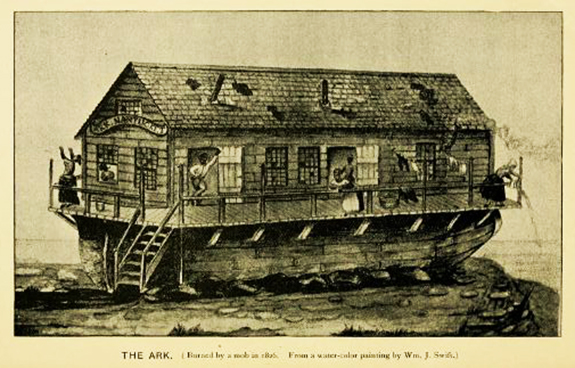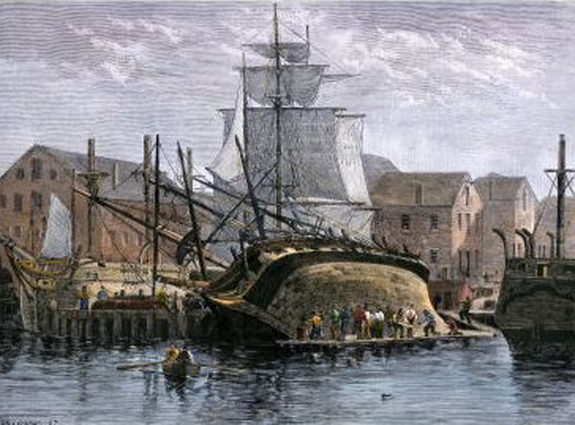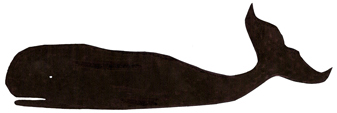Local New Bedford, Ma. History
1820 - 1829 In Chronological Order
|
 |
This is the Infamous "Ark" of 1826
It became a brothel and inspired a mob riot |
1820
St. Mary's Church is built with an Irish congregation, on Allen Street near the corner of Orchard, with Father Lariscy as pastor. In 1849, St. Mary's parish bought the former Universalist Church located on the corner of School and Pleasant Streets. |
| |
1820
Sept. 18 at 4:30 in the morning a fire broke out at Enoch Horton's bake house, and although 7 fire engines responded it quickly spread to destroy several buildings.
Destroyed was John Perkins' 3 story store, a paper staining factory, John Harrison's paint store, a store owned by Gilbert Russell and shared by William Card, a block maker, William Tallman's building occupied by a grocer named Churchill, also two cooper shops, a shoe shop, a blacksmith shop and a barn.
The fire partially damaged two other buildings, Peter Barney's store and Gilbert Russell's House.
It was said that if the fire had not been contained at that time it would have spread out of control and burned the whole area and would have been a disaster equal to the burning of Savannah.
Of the 7 engines responding, 2 were from across the river in Fairhaven and Oxford. |
| |
1820
Population of New Bedford is 3,947.
The Benjamin Rodman house is begun to be built on North Second Street.
The Sundial building was built on the northwest corner of Union and Water streets. |
| |
1821
Again as previously mentioned since 1815 there were dramatic climate shifts. There was a freak natural phenomenon. At sunrise of Friday June 19, the thermometer stood at 12 degrees below 0 at sunrise and the following Thursday all of Buzzards Bay except for a small rip near Naushon Island was frozen. |
| |
| Daniel K. Whittaker opened a classical school in New Bedford that year.. |
| |
A Mr. Phillips opened a dancing school at Colonel Nelson's Hotel, October 15, 1821.
He charged $5.00 for the quarter. |
| |
| The Robeson mansion ws built on William Street. |
1821 - 1822
The first fire engine at the head of the river was a bucket machine with a hose and tower.
It was a powerful machine. In its first test, Samuel Pierce stood on top of it's tower to direct the hose when it burst at the butt and the full force of the water lifted him quite high in the air. |
| |
1822
An 1822 bylaw levied a fine to anyone who would “play at ball, fly a kite or run down hill upon a sled… in any street of that part of the town commonly called the Village of New-Bedford” |
| |
1822
A building was built first as a market and town house then later converted to the police station on Second Street just South of Union Street.
1822
The 1785 wooden framed Quaker meeting house on the northeast corner of Spring and Seventh streets was moved to the South-West corner of the same intersection and later in 1830 bought by Nathan and Polly Johnson. The Johnsons lived at 17-21 Seventh Street.
A new brick meeting house was built in its place, and as of 2013 it is still standing.
At the time, it was the only "church" south of Elm Street.
In this year, Nathan Johnson asked to be admitted as a member of the New Bedford "Friends" meeting.
Apparently he was not admitted as Charles W Morgan had thought he would be.
Dissention within the Quaker "Friends" society over many separate issues was causing some to drop out. |
| |
1823
January 24th A woman and a boy were "taken up" for passing counterfeit money.
On March 30th, a tremendous snowstorm and gale began. As a result, there was no communication with the outer world for a week.
On December of that year, a remarkable rain storm occurred that lasted for twenty-four hours and left 4-5 inches of rain. The record said " the oldest people do not recollect such rain." |
| |
1823 April 23
A structure built as the "Town School" was built and ready for use. It was a grammar school.
The issue of financial expenditure for public funding for the education of all of the children in town came to a vote. It did not pass. The outcome was 189 against and 142 for expenditure.
On December 10, the first Freemason Lodge, Star in the East Lodge, F. and A. M. in the City was chartered. |
| |
1824
Until this year cows were allowed to roam free about town except at night.
In this year 1824 the town was alarmed by another outbreak of smallpox.
A Committee of four selectmen was formed to raise money for the purpose of preventing the spread of the disease. |
| |
1824
On January 17th, a company of black theatrical actors arrived in town with intentions of performing for a few days.
On the 20th, an account by young Mr. Anthony tells of going to the African Theater held at Cole's Tavern. The play was "Pizarro". "It was a real sport for a time and a real burlesque of the stage. One fair damsel gave us two good songs."
On the 27th of January, the selectmen prohibited the African Corps from performing any more of their theatricals and threatened them with prosecution.
Accounts from that time tell us that people ate oysters on a regular basis as well as mutton.
The newly organized Mozart Society gave a public performance in Rev. Dewey's meeting house. The free use of the town hall was granted to the society by town authorities for rehearsals.
In this year, the school department decided to stop instructing the students in Greek and Latin. |
| |
1824
The group known since it's establishment as the Bedford group of night watchmen became officially known as the "Night Watch", to combat a steady growth of robberies usually occurring after the businesses had closed at night. |
| |
1824
The Morning Mercury tells us that, for two days, there was an exhibition of two Egyptian mummies on the second floor of Peleg Gray's store on Water Street. Admission was 25 cents. |
| |
1825 June 6th
Benjamin Lindsay opened a reading and news room. It remained a popular meeting place for businessmen for 60 years. |
| |
1825
A town clock was purchased in May of this year. |
| |
1826 May 23
At a special meeting the town voted to petition the legislature that a public gaol for Bristol County should be built in New Bedford. |
| |
1826 August
A body was found by some boys picking huckleberries in the woods near the notorious neighborhood called Hard Dig" on Kempton Street just west of what later was a baseball park...
They went back and brought some citizens with them, but the body was gone although evidence was there that the body had been removed. It was thought to be a ship carpenter who had gone missing.
The neighborhood was considered dangerous, and it's vicious classes were a menace to good order. They made it unsafe to travel near there after dark.
A mob was organized on the corner of Kempton street, and they first pulled down the house of Jake Peterson, a leader of the place and burned it.
The rest of the buildings suffered the same, and in two hours time the mob had effectually cleaned out the whole nuisance.
Flushed with their success, they proposed to raid the "Ark" that night, but it was postponed until the next night. They had heard that the residents of the Ark had a death of a baby that day and waited till the next day after the child was buried to attack.
|
| |
1826 August
The story of "The Ark" has been told in this fashion.
The first "Ark" was the hull of an old whaling ship "Camillus". (see 1829 for the second "Ark".)
The first one was located a few feet ashore at a point at the end of High street, which is just north of the foot of the Fairhaven-New Bedford bridge.
High street was the easterly extension of Charles Street (both no longer exist), and it ran just south of Kempton and parallel to it, down to the river.
It rested on blocks at the shoreline just above the high tide level near Water Street. and High Street.
Later a brick building was built there.
The boat had been outfitted with a house built on the top of the deck and a four foot wide walkway all around the outside of the rail. It had a set of stairs to get aboard the vessel.
The name "The Ark" came from a ship named "The Ark" that was too old to be used and in port to be broken up. That stern board was put on the Camillus and so then called "The Ark".
In the beginning, it was occupied by decent people of moderate means but soon became a brothel.
It's existence was a moral offence to the community, and it's removal was earnestly desired by the good citizens.
People aboard had learned that a mob was coming and earlier in the day prepared themselves with rocks and missiles and bottles of scalding hot water.
The mob arrived, and though Timothy Griffin read the riot act he was marched off and the mob began with hooks and ladders and the attack commenced.
Stones and bottles of hot water flew in all directions until they brought out a cannon and aimed it straight at the vessel.
The occupants then marched out and "The Ark" was destroyed with axes and crowbars then burned.
The amuzing part is that the cannon was a "Quaker" in that it didn't work. (Quakers would not take up arms). It was found filled with mud. It was never contemplated to be really used. So, to make a show of it, they rammed a fake cartridge in the barrel and prepared to use a match to fire it.
This was the bluff that motivated all aboard to abandon the vessel.
The fire called out the fire engines, but they only worked to protect surrounding buildings.
This was reported by Capt. Joseph Wilcox, Jr. who was present but not one of the rioters.
Some 50 citizens were summoned to the Court in Taunton to give account of the riot, and they all proved to be "Know Nothings", so nothing was made of it. |
| |
| 1827, June 12
The first issue of the New Bedford Courier appeared published by Benjamin T. Congdon.
|
| |
1827
June 11, The first New Bedford High School, is established.
John F. Emerson principal. It was s abolished in 1829.
Mr. Emerson then ran a private High School for the next 8 years.
In 1837, he became the head of the new Public High School that was provided under a mandatory state law. |
| |
1828
November 14
A circus was advertised in the New Bedford Courier on November 14, 1828 to appear every evening except Sundays, on County Street opposite the academy with the best equestrian company in America.
The Circus house or amphitheater as it was called was located on the northwest corner of County and Elm Streets, just north of the County Street M. E. Church.
The circus was formerly a stable and remodeled and opened by Mr. Hians much to the annoyance to the citizens. ( August 1, 1836) |
| |
1828
The Lyceum Society was organized on December 8, 1828.
The mansion house of William Rotch on the corner of Union and North Second was opened as a hotel by J. Webster on December 19 1828
|
| |
| 1828 -1829 The first Ash Street Jail was built. Later in 1888 the newer Ash Street Jail was replaced with a larger structure. See the local links page for more links to the jail. There was an addition also in 1858. See the page on this site for the info from 1888 |
The Marine Bank Building was constructed on Second and Union Street.
|
1829
A second "Ark" had been made up from the old hull of a ship called "The Indian Chief".
Located a little north-west of the location of the first "Ark". See the location of the 2nd Ark.
It was occupied by the worst classes and was the abode of debauchery and evil doing.
Any attempt to banish the scourge failed, and it was apparent that the law was held in contempt.
In the spring of that year, the Elm Street M. E. Church was set on fire.
It had contained barrels of oil and the fire was extinguished but had the oil caught fire it would have spilled down the street and burned much in its path.
Many citizens thought that occupants of the second "Ark" had started the fire.
Mrs. Josiah Richmond related this to Ellis the historian.
On August 29th the second "Ark" riot occurred.
The Ark was kept by a notorious character named Titus Peck, a bully and desperado.
He and his associates were a menace to the whole town. The selectmen were afraid to interfere with them.
Rumors spread, and so did a plan for a meeting in town hall.
On the Saturday of the meeting over 200 men showed up. The crowd was excited, and many prominent city leaders tried to calm the situation.
Timothy Coffin read the riot act but to no avail.
When the 9 o'clock bell of Dr. Dewey's church rang out a shout from many throats rang up "Jerry is in town" Hurrah for the Ark" and they proceeded to go there.
A fire truck with hooks and ladders mysteriously arrived and about 25 men in disguise proceeded to destroy the thing and by midnight it was done, and most people went home.
It caught fire at that time, and the fire spread to some small buildings homes nearby.
By morning, it was burned to the ground.
The fire department was on hand and were commended for what it didn't do.
He was most likely born in 1777 because, in 1850, the US Census described Titus Peck as a 73 year old Mulatto.
Sources mention his birth in Bristol, Rhode Island. He came to live in New Bedford around 1820.
When he was in his 80's, he was described as a drunk living in the local poor house with about 48 other people including what appeared to be a 3 month old orphan and an insane sailor from Germany. |
 |
This is how the bottom of a ship was worked on to clean and re-copper the bottom |

